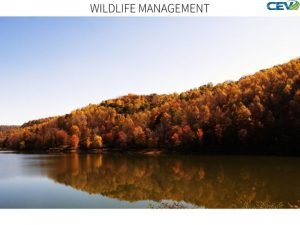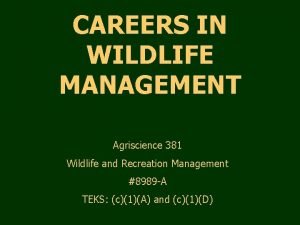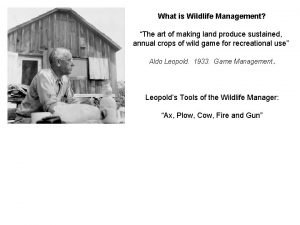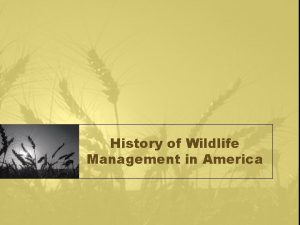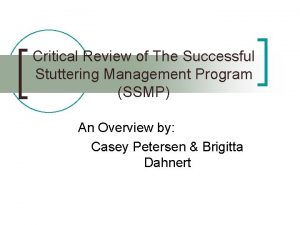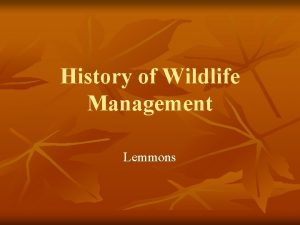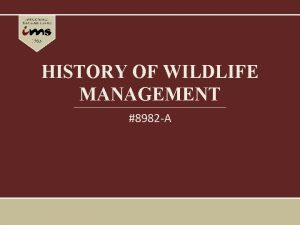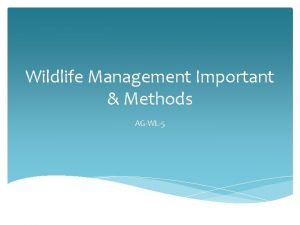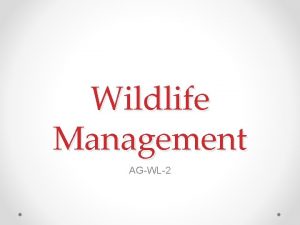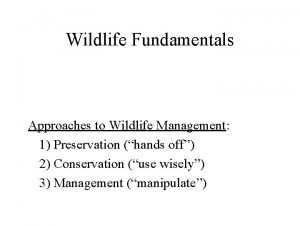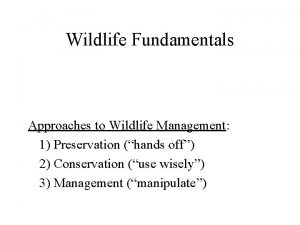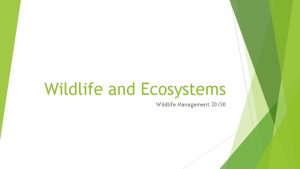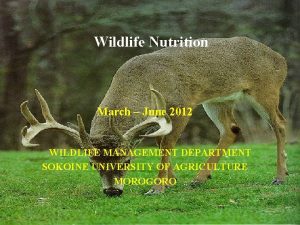Importance of wildlife health for successful wildlife management


















- Slides: 18

Importance of wildlife health for successful wildlife management: experience from Kazakhstan Steffen Zuther Association for the Conservation of Biodiversity of Kazakhstan/ Frankfurt Zoological Society International Workshop on Sustainable Wildlife Management in Central Asia: Practical Experience and Way Forward , Ashgabat, 01. -03. 09. 2015

Introduction of Saiga antelope • Commercial use of Saiga antelopes at Soviet time • Population at that time about 1 million animals • Decline of saiga population numbers by more than 95% in 10 years time since 1993 • Reasons: primarily poaching for horn of males • Already since 1995 listed in CITES Appendix II • Since 2002 Saiga tatarica included in Appendix II of CMS, since 2008 also S. t. mongolica 2

Distribution of Saiga antelopes 3

Photo: R. Frey 4

2015 5

History: 1980 ies • In May 1981, 100 thousand animals die in the Betpak. Dala population • 1984, more than 250 thousand saiga die in the Ural population • In 1988, about 434 thousand animals die in the Betpak-Dala population • Symptoms seem to be similar to what has been observed recently • Officially, Pasteurellosis was declared responsible for the dieoffs 6

History: since 2010 (1) • In May 2010 officially 12000 saigas of the Ural population in West Kazakhstan died during few days • An infection with the bacteria Pasteurella was determined as cause for the death • Alternative explanations were primarily developed by the local population (strange fog, near military testing site, poisoning, …) • In May 2011: again 450 saigas died at the same place • Hypothesis: feeding on extremely lush vegetation led to digestive problems, production of toxins, and mortality 7

History: since 2010 (2) • In May 2012, 926 animals of the Betpak-Dala population died at the end of calving • In September 2013, about 1000 animals died in the Betpak-Dala population 8

Problems • Nobody was prepared for such an event • Slow and late reaction on the die-offs (partly due to far distances) • No veterinarians were used to work with wildlife • No good quality sampling of animals • No investigations besides samples from dead animals • Lacking knowledge about saiga ecology no definite conclusion about the possible cause 9

Improvements of the situation since 2010 • Governmental research programme on saiga diseases, involving intensive field research and monitoring (saiga health status) • International co-operation with leading wildlife specialists • Trainings/workshops for veterinary services from Kazakhstan 10

Investigations in 2015 • Description of the die-off since the very beginning • Timely and comprehensive sampling as well as cleaning procedures • Samples of dead and sick animals as well as environmental components • Analysis of weather data • International expertise involved • Various laboratories • Interdisciplinary • Special expedition to take a look at environmental factors/domestic livestock • Transparency • Problem: Nothing really fits 11

Theories about potential causes • • • Pasteurellosis Tick-born disease (theileriosis) Other vector born disease (mosquitoes? ) Poisonous vegetation Too lush vegetation Saiga took up Clostridia with soil Bloom of toxic algae Poisoning through rocket fuel General pollution of the environment Something new, unknown? 12

Saiga risk/stress factors (local) Weather • Wet conditions (diseases spreading easily, “too good food”) • extreme occurrence of vectors Hunter’s behaviour • Control / elimination of predators • Poaching • Leaving of offals Saiga ecology • High gregariousness • Increasing density Other wildlife • Decreasing scavengers • Decreasing predators • Misbalanced species assemblage Habitat • Fragmentation • Industrial use • Decreasing pasture quality • Rocket launches • Environmental pollution • Water supply • Worsened health status • Decreased immunity • Infectious diseases • Mass mortalities Livestock • Weak health control • Introduction of new breeds • Un-adapted use of vaccines 13

Saiga risk/stress factors (local) Weather • Wet conditions (diseases spreading easily, “too good food”) • extreme occurrence of vectors Hunter’s behaviour • Control/elimination of predators • Poaching • Leaving of offals Saiga ecology • High gregariousness • Increasing density Other wildlife • Decreasing scavengers • Decreasing predators • Misbalanced species assemblage Habitat • Fragmentation • Industrial use • Decreasing pasture quality • Rocket launches • Environmental pollution • Water supply • Decreased health status • Decreased immunity • Infectious diseases • Mass mortalities Livestock • Weak health control • Introduction of new breeds • Un-adapted use of vaccines 14

Results so far • According to field and first laboratory investigations, a hemorrhagic septicaemia has been the final cause of death for saiga (involving Pasteurella and Clostridia) • Triggering mechanism unclear so far, but: • The winter 2014/15 was extraordinarily warm and rich in snow • Large amount of melting water combined with rainfalls led to moist conditions in spring • No indications for a role of rocket fuel (heptyle) • No abnormalities in the vegetation cover • No proof for a role of heavy metals or radiation • Some blood parasites found 15

Further steps • Pathological and environmental samples are still being analysed • Samples given to international laboratories • International research team working on the die-off • Technical meeting under CMS in October in Tashkent • Research programme planned for 2016 -2018 • Centre of wildlife health research to be established at an Institute in Kazakhstan • Hunting moratorium until 2030 16

Lessons learnt 1. Monitoring needed: 1) continuously (investigate health status whenever possible) and 2) during key moments of a species lifecycle 2. Veterinarians need to be trained to work with wildlife 3. Wildlife health monitoring needed (centre for wildlife health) 4. Existence of Rapid response unit (interdisciplinary) for outbreak reaction would be optimal 5. Intense veterinary care for domestic animals in the distribution area of the species of interest 6. Vaccinations among domestic animals should take into account needs of wild species (adapt vaccination programmes to actual needs) 7. Be careful with introduction of wild/domestic species to the distribution area of the managed species 8. Do not underestimate the importance of wildlife health issues for wildlife management / conservation !!! 17

Thank you for your attention! 18 steffen. zuther@acbk. kz
 Manipulative wildlife management
Manipulative wildlife management Objectives of wildlife management
Objectives of wildlife management Careers in wildlife management
Careers in wildlife management Wildlife management as an art
Wildlife management as an art History of wildlife management
History of wildlife management Problems in implementing portfolio management
Problems in implementing portfolio management Successful stuttering management program
Successful stuttering management program Kontinuitetshantering
Kontinuitetshantering Novell typiska drag
Novell typiska drag Nationell inriktning för artificiell intelligens
Nationell inriktning för artificiell intelligens Vad står k.r.å.k.a.n för
Vad står k.r.å.k.a.n för Shingelfrisyren
Shingelfrisyren En lathund för arbete med kontinuitetshantering
En lathund för arbete med kontinuitetshantering Personalliggare bygg undantag
Personalliggare bygg undantag Vilotidsbok
Vilotidsbok Sura för anatom
Sura för anatom Förklara densitet för barn
Förklara densitet för barn Datorkunskap för nybörjare
Datorkunskap för nybörjare Stig kerman
Stig kerman

